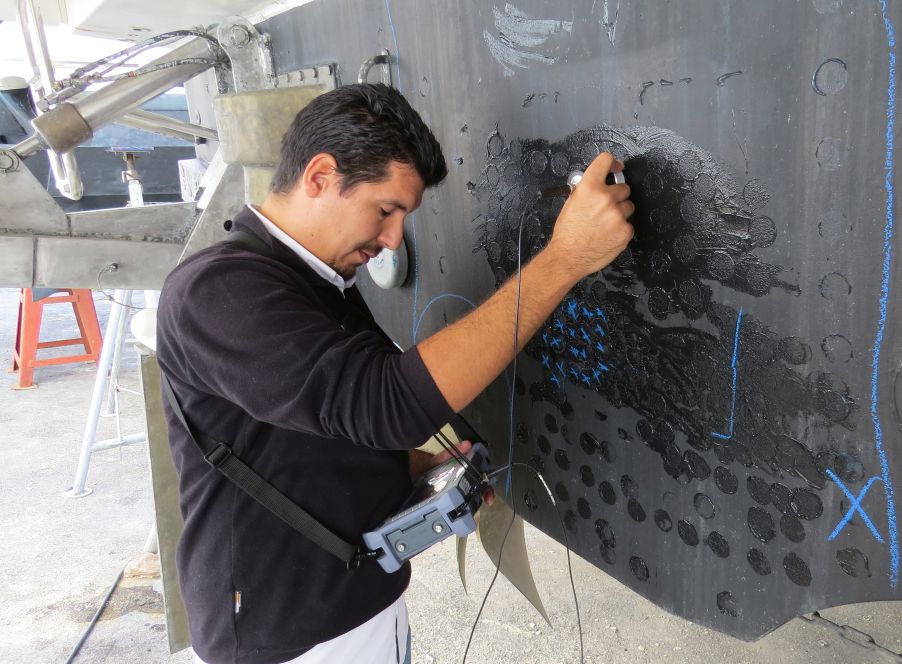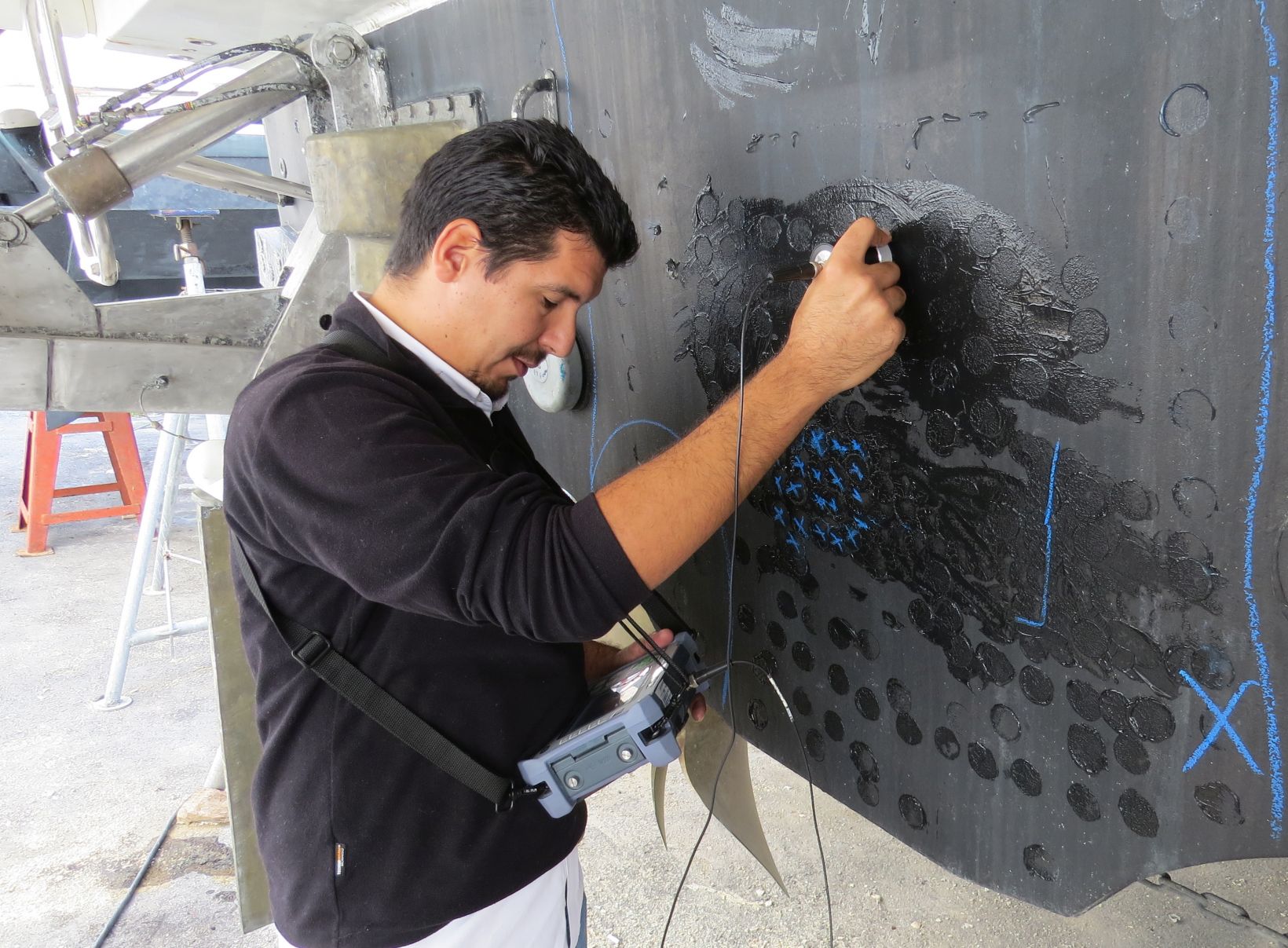In the marine industry, ultrasonic testing (UT) can nondestructively detect flaws in boats, yachts, and other marine vessels. Routine UT inspection helps ensure marine vessels meet regulatory requirements and laws to keep crews, passengers, and cargo safe.
One company that makes ultrasonic testing a priority is marineSOLUTIONS, an international yacht surveyor.
Yacht Surveys of New and Used Marine Vessels
marineSOLUTIONS provides yacht survey, consulting, and management services in the Eastern Mediterranean. Located on the Bodrum Peninsula in Turgutreis, Turkey, the company conducts surveys on used and new sea vessels to verify their condition and value, as well as determine and evaluate damages. These surveys can provide detailed inspection information for an underwriter determining if an incident is covered or for legal offices preparing a claim on a vessel.
Their vessel surveys include ultrasonic testing with our EPOCH™ 650 flaw detector. The UT inspections of boat materials include:
We chatted with Cem Baykent, a materials science engineer and marineSOLUTIONS surveyor, to learn more about ultrasonic testing in the marine industry. |  |
The Challenges of Boat Inspection and Maintenance
The International Association of Classification Societies (IACS) provides a system to promote the safety, regulation, compliance, and maintenance of ships and offshore units. Each society establishes rules with technical standards.
Despite these standards, nondestructive testing (NDT) isn’t mandatory in the marine industry like it is in the aerospace industry. Further, inspection documentation isn’t included for a yacht or pleasure craft if an IACS member does not classify it. Due to the artisan background of most yacht manufacturers, many building skills aren’t standardized.
Most yachts also aren’t built with inspection in mind. Interiors are often packed with liners, equipment, tanks, lines, and machinery. This design prevents access to the hull shell and its reinforcement from the interior. As a result, dismantling is often only justifiable after a flaw or damage is strongly suspected.
Boat materials can also be challenging to inspect. To minimize weight, many modern boats are built from composite materials that combine fibers and resin matrices. Fibers might be randomly arranged, then flattened into a sheet (known as a chopped strand mat) or woven into a fabric. The fiber material is often glass, aramid, or carbon; the matrix is often based on polymers such as polyester, vinyl ester, or epoxy resins.
Due to the fiber-reinforced composites commonly used in boats and the decreasing safety margins of boat designs and materials (e.g., thinner hulls in modern yachts), the need to characterize and find flaws in the materials has increased.
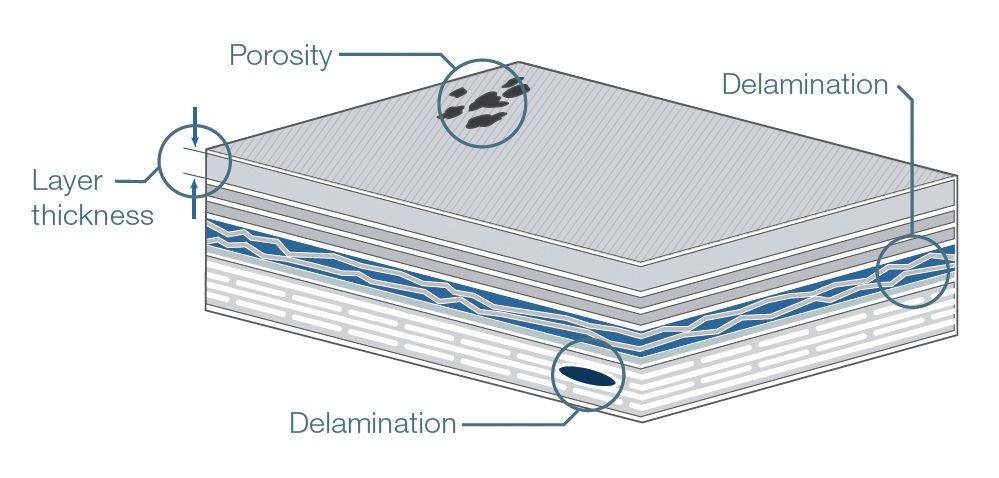
Delaminations, flaws, and defects in composite fiber layers
Hidden internal flaws and defects in a composite structure can have many sources: manufacturing anomalies, applied stresses or weaknesses, accidents, or improper repairs. Flaws and defects can significantly impact a boat’s structural integrity.
Inspectors like marineSOLUTIONS use NDT ultrasonic testing to accurately locate and size flaws, cracks, voids, delaminations, and other defects in boats, yachts, and other marine vessels.
Understanding Ultrasonic Testing in the Marine Industry
Simply put, ultrasonic testing uses high-frequency sound energy to conduct examinations and make measurements. UT can be used to detect and evaluate flaws, take dimensional measurements, perform material characterization, and more.
An ultrasonic flaw detector uses a transducer that generates sound waves and measures the time it takes for that sound to leave a transducer, travel through a material, bounce off a reflector, and return to the transducer.
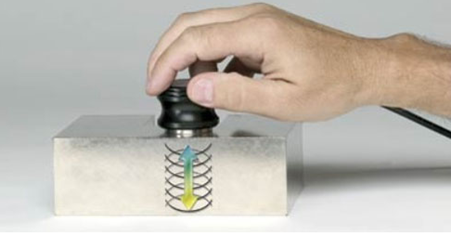
A sound pulse generated by a transducer travels through a test piece and reflects back from the inside (here lower) surface.
An ultrasonic flaw detector can be used to locate and size discontinuities such as cracks, voids, porosity, and disbonds in various materials and welded joints. Flaw detection can be applied to almost any engineering material. Most tests involve steel and other structural metals, but flaw detectors can also be used with great success on plastics, composites, fiberglass, and ceramics.
A flaw detector can also measure material thickness reasonably but isn't designed for precision thickness. To learn more, review our Ultrasonic Flaw Detection Tutorial.
NDT technology such a flaw detector is a powerful way to determine the integrity of a boat's components or structure and discover flaws without causing any damage. Since NDT does not harm, stress, or destroy materials, it saves time and costs when inspecting boat structures and components.
NDT inspections can be performed during the vessel building process, pre-delivery, pre-purchase, routine surveys, damage inspection, or as a part of post-repair inspections. In the commercial marine craft industry, ultrasonic NDT is regularly performed on steel and aluminum vessels to detect and quantify corrosion. In similar ways, ultrasonic NDT can be used to measure the thickness and integrity of composite structures.
Inspecting structural welds in metals is a common ultrasonic NDT application in the marine industry. Flaw types in welds include cracking, lack of fusion, incomplete penetration, porosity, and slag inclusions. All these flaws are potentially detectable using ultrasonic testing.
Combining UT with NDT Expertise for Boat Inspections
Without an NDT inspection program at the manufacturing stage, there are often no reference standards for how non-commercial vessels and pleasure crafts are manufactured. This makes the work of ultrasonic testing more challenging.
Inspectors such as marineSOLUTIONS must use their knowledge and experience. With this in mind, marineSOLUTIONS set up a small lab to examine different boat materials from multiple composite material types to different metals.

Cem Baykent uses the EPOCH 650 flaw detector with the M2008 transducer to examine composite materials of marine vessels.
"Ultrasonic testing on composites is still a niche, undiscovered, and untapped area in the NDT world because there is no regulation or standard driving what to do and when. So marineSOLUTIONS is largely building its own procedure and bringing expert NDT knowledge through engineering staff," said Cem.
Besides composite materials, marine vessels are often built in aluminum or steel. Just about anything made of metals is subject to corrosion, particularly in the marine environment.
Cem noted that overlooking metal hull inspections is surprisingly common even though compromised hull integrity is a major safety risk. In simple terms, the hull is the exterior, structural shell of a vessel that’s partially immersed in the sea. It protects the cargo, machinery, and accommodation area of a vessel from weather, flooding, and structural damage.
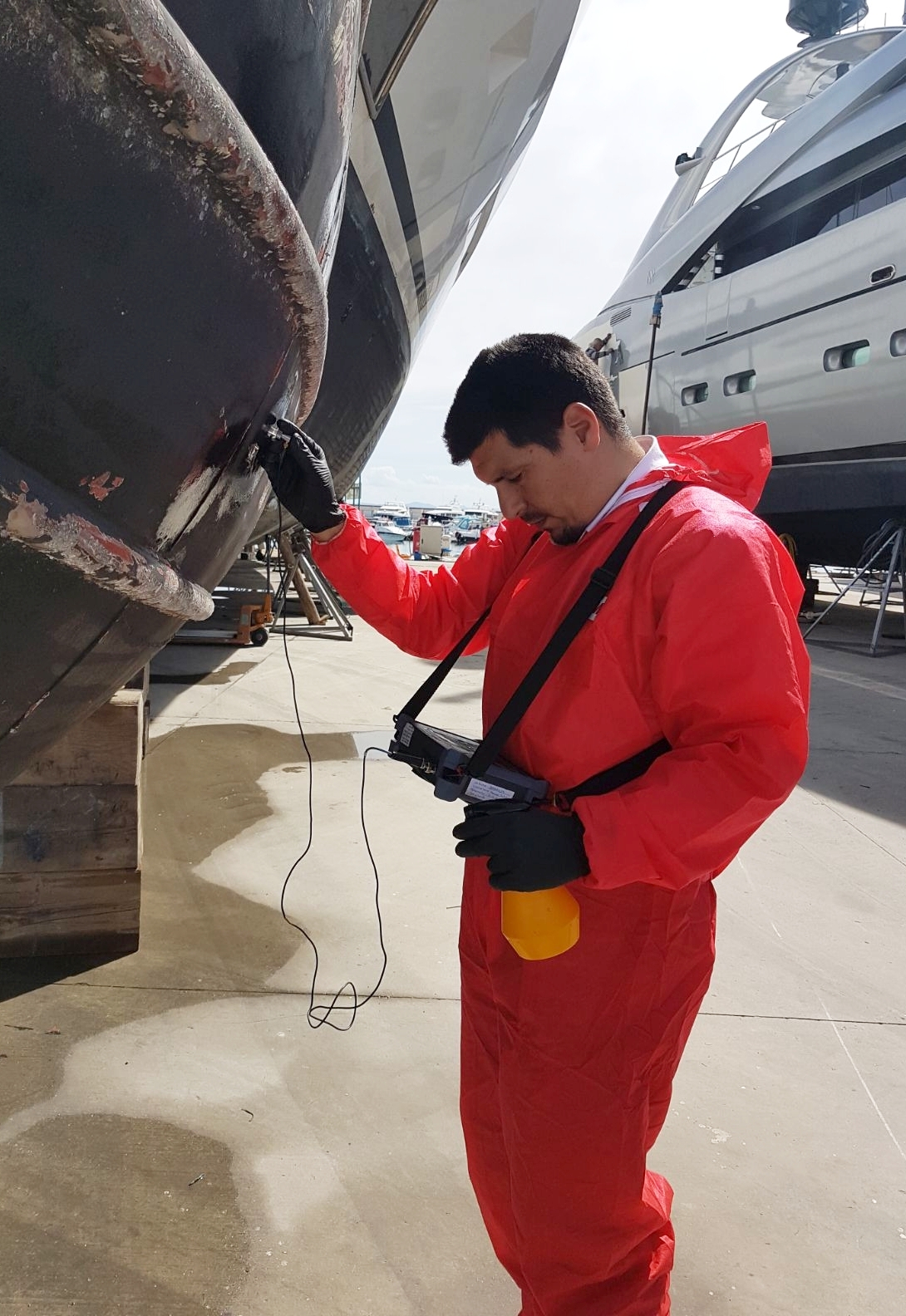
Cem Baykent inspects the hull of a marine vessel using the EPOCH 650 ultrasonic flaw detector
Boats are regularly lifted ashore to inspect hull plates from the exterior, even if it is just for a visual inspection and tapping. However, the fillers, coatings, and paint layers on yacht hull exteriors can make visual inspections challenging.
Above all, visual inspection only provides limited insight. Corrosion often progresses from the interior. Only after most material is wasted from corrosion can interior damages be detected from the outside through conventional methods.
Interior corrosion mainly progresses in areas almost impossible to see during bilge inspections. Access to bilges for visual inspection is often limited due to tanks, machinery, and other components and structures that get in the way. If undetected and left untreated, corrosion can weaken hull plates and lead to dangerous leaks, and eventually, structural failures. Inspecting hull plates regularly is important to improve safety and minimize costs.
A Trusted Ultrasonic Flaw Detector for Yacht Surveys
Along with an experienced team, marineSOLULTIONS has an assortment of equipment and standard samples to meet many requirements. As the backbone of the equipment, they rely on the EPOCH 650 flaw detector due to its combination of performance and usability.
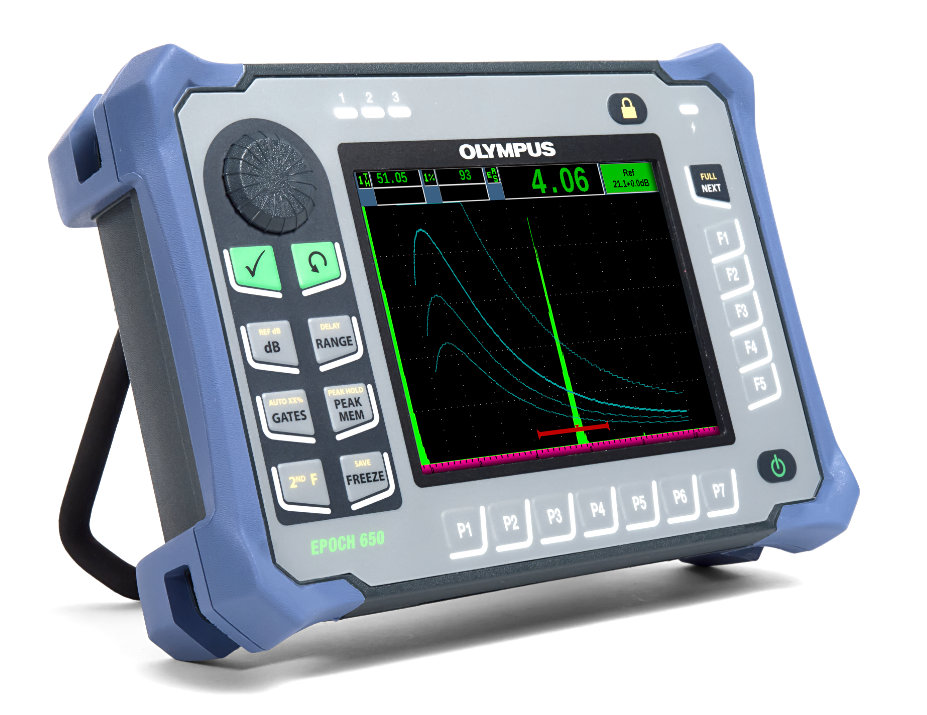
Olympus EPOCH 650 ultrasonic flaw detector
Here are three ways marineSOLUTIONS uses the flaw detector:
1. Ultrasonic Testing of Composite Boats and Spars
To inspect composite vessel structures and materials, marineSOLUTIONS pairs the EPOCH 650 flaw detector with an Olympus M2008 delay line transducer (0.5 MHz, 1 in. diameter). This transducer is ideal for highly attenuative composite structures.
"Composite materials for yachts are anisotropic, which makes it even more challenging. You can tell more about anisotropic materials using the M2008 transducer," explained Cem. "The M2008 is very strong to get through thick fiber reinforced polymer (FRP) composite materials. It works like a miracle and offers straightforward results. We have tried other reputable companies' transducers designed for the same purpose and have not achieved even close results."
In composites, ultrasonic testing can be used to detect:
- Uniformity of laminate thickness
- Presence and type of delaminations
- Presence of voids and/or porosity
- Quality and bonding of laminate and integrity of repairs
- Inclusions and alien material presence in laminate
Ultrasonic testing of composite boats and spars has many advantages, including:
- One-sided access is sufficient
- Portable equipment for inspections at remote locations and working aloft
- Minimal or no surface preparation
- Highly accurate in determining the exact point of a hidden anomaly and its main characteristics, such as depth, size, and shape
- Provides instant results and data
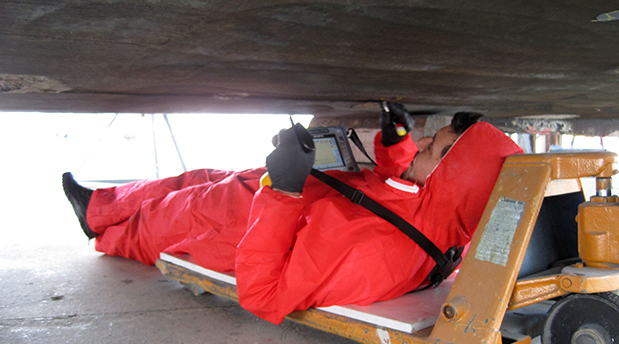
Cem Baykent performs ultrasonic testing of composite boats and spars using the EPOCH 650 flaw detector
2. Corrosion Measurement of Hull Plates with Ultrasonic Testing
Another way marineSOLUTIONS uses the EPOCH 650 flaw detector is to measure corrosion on hull plates.
Cem explained, "Hull and mast damages are quite common, and ultrasonic testing gives us the means to establish the spatial extent of the damages. This knowledge leads to the peace of mind of all involved and gives us valuable input to estimate repair costs. Both are invaluable advantages."
Metal plate thickness can be assessed nondestructively with ultrasonic thickness gauges without removing fillers, paint layers, or other coatings. It is important to note that when assessing pitted plates, these devices deduct minimum plate thicknesses by preset algorithms and can be misleading at times.
marineSOLUTIONS turns to the EPOCH 650 flaw detector with a DL4R-6X20 (4 MHz) dual element transducer for corrosion inspection on metals. This enables the ultrasonic echo spectrum to be displayed. From waveform, attenuation, and phase shifts, an experienced NDT surveyor can infer quite a bit of information about a plate or structure. The surveyor must also distinguish between true echoes, false reflections and diffractions, and more.
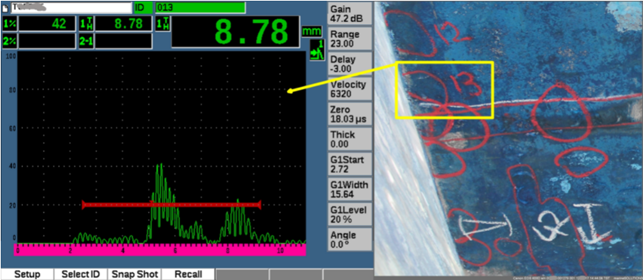
The EPOCH 650 ultrasonic flaw detector displays a spectrum on a progressively pitted aluminum hull plate. The distinct double hump with the high summit to left indicates severe pitting corrosion. On the right, the visual inspection of the related hull plate section doesn’t reveal any indication of pitting corrosion. The damages are hidden by the faired and coated external surface, as well as the tanks and other internal structures that block the interior.
3. Ultrasonic Testing of Welds
marineSOLUTIONS also uses the EPOCH 650 flaw detector with an Olympus AM4R-8X9-70 angle beam transducer to inspect welds.
While straight beam techniques can be highly effective at finding laminar flaws, they are ineffective when testing many common welds, where discontinuities are typically not parallel to the surface. The combination of weld geometry, orientation of flaws, and presence of the weld crown or bead require an inspection from the side of the weld using a beam generated at an angle.
Shear wave testing, also known as angle beam inspection, is a UT technique used primarily for weld inspections. Weld inspection is performed by introducing shear waves into a plate at a selected angle and manipulating the transducer to scan the entire weld.
In typical inspections, the sound beam travels at the generated angle to the bottom of the test piece and then reflects upward at the same angle. Moving the probe back and forth causes the sound beam to sweep across the weld’s full height. This scanning motion enables inspection of the entire weld volume and the detection of discontinuities both at the fusion lines and within the weld body.
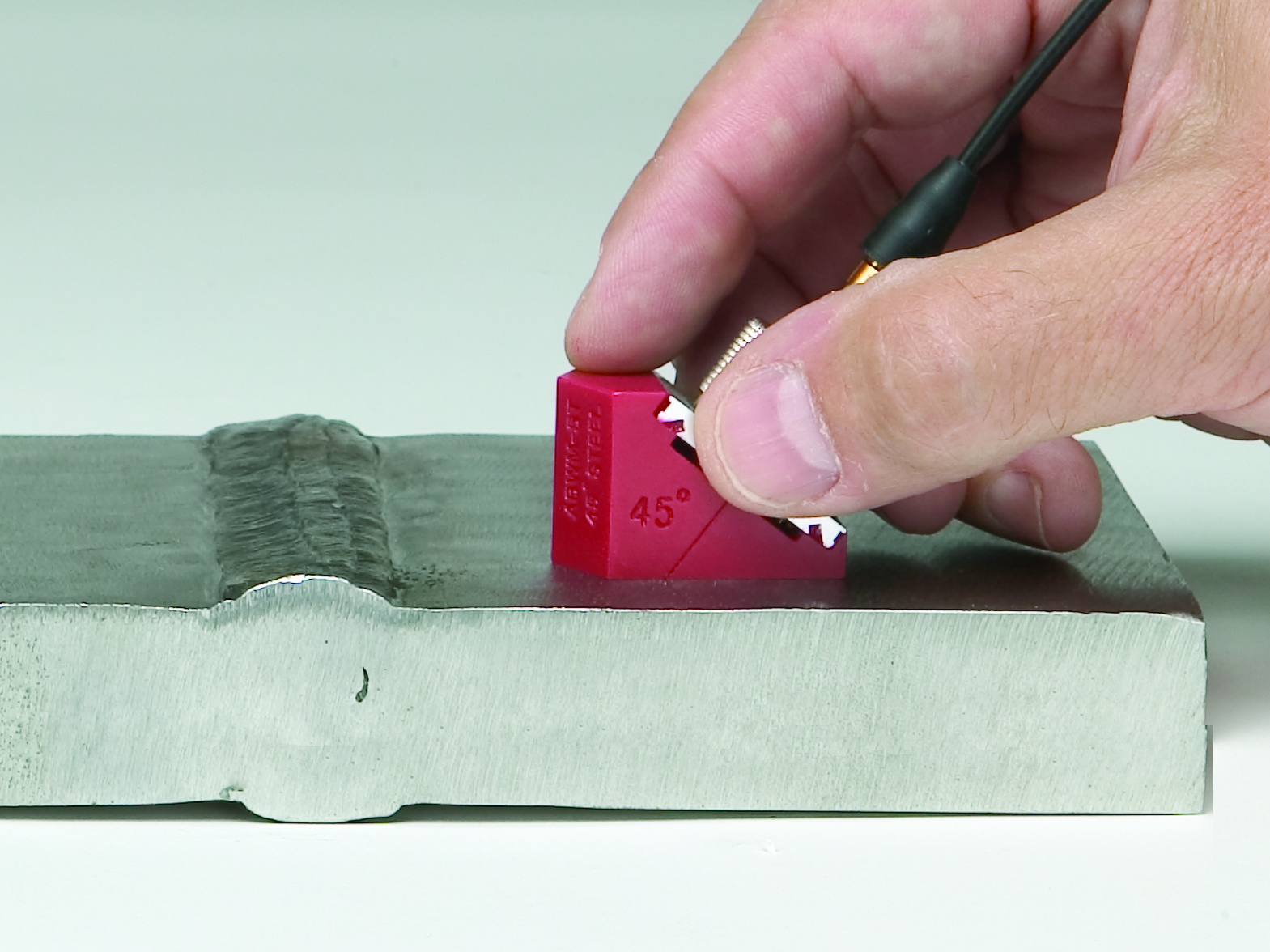
Angle beam transducers are single element transducers used with a wedge to introduce a refracted shear wave or longitudinal wave into a test piece. Here a 45° wedge is shown.
UT inspection can detect the following defects in welds:
- Cracks in the weld zone
- Discontinuities and incomplete penetration of weld joints
- Lack of fusion in welded joints
- Porosity in welded joints
- Slag inclusions in the welded joints
- Areas with distortion
- Stratification of weld metal
Working with Olympus as an NDT Equipment Supplier
When marineSOLUTIONS decided to invest in an ultrasonic inspection device, they contacted multiple NDT equipment suppliers. Olympus stood out because of its reputation for high-quality products and knowledgeable personnel.
Cem mentioned a past survey where he’d discovered delamination in a carbon composite mast using the EPOCH 650 flaw detector. Cem reported this flaw to the customer, and based on the reputations of marineSOLUTIONS and Olympus, the owner decided to destructively inspect the yacht part. Destructively inspecting a carbon spar makes the mast unrepairable and unusable.
“While the owner gave the decision, it was pretty stressful to witness a high-value carbon mast being destructively inspected based on our findings. Still, we were confident in our expertise and the reliability of the Olympus equipment,” said Cem.
The flaw was found at the exact reported location, and further inspection led to the discovery of a manufacturing defect. The survey led to the replacement of the entire mast by the manufacturer, which was worth about $250,000.
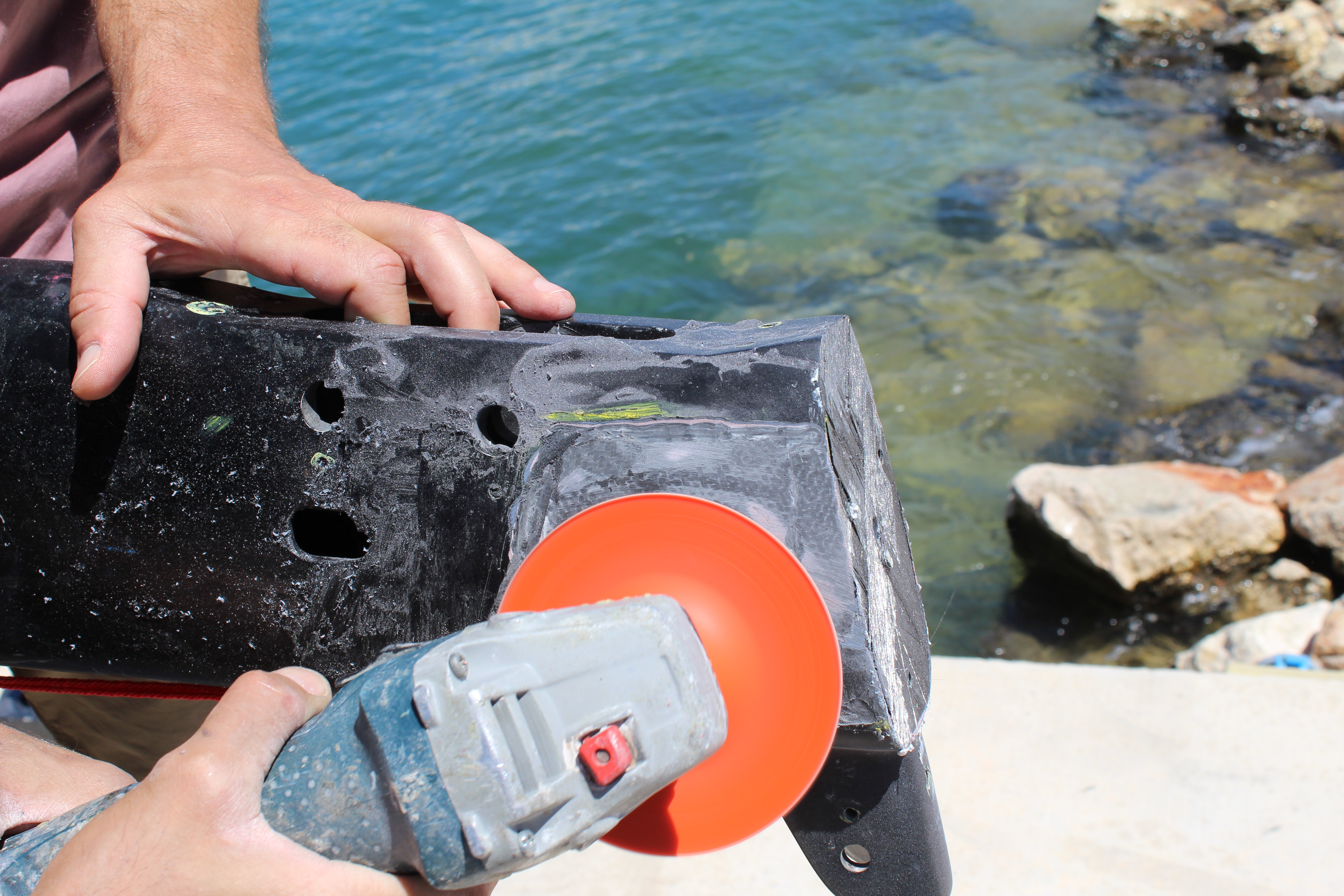 | 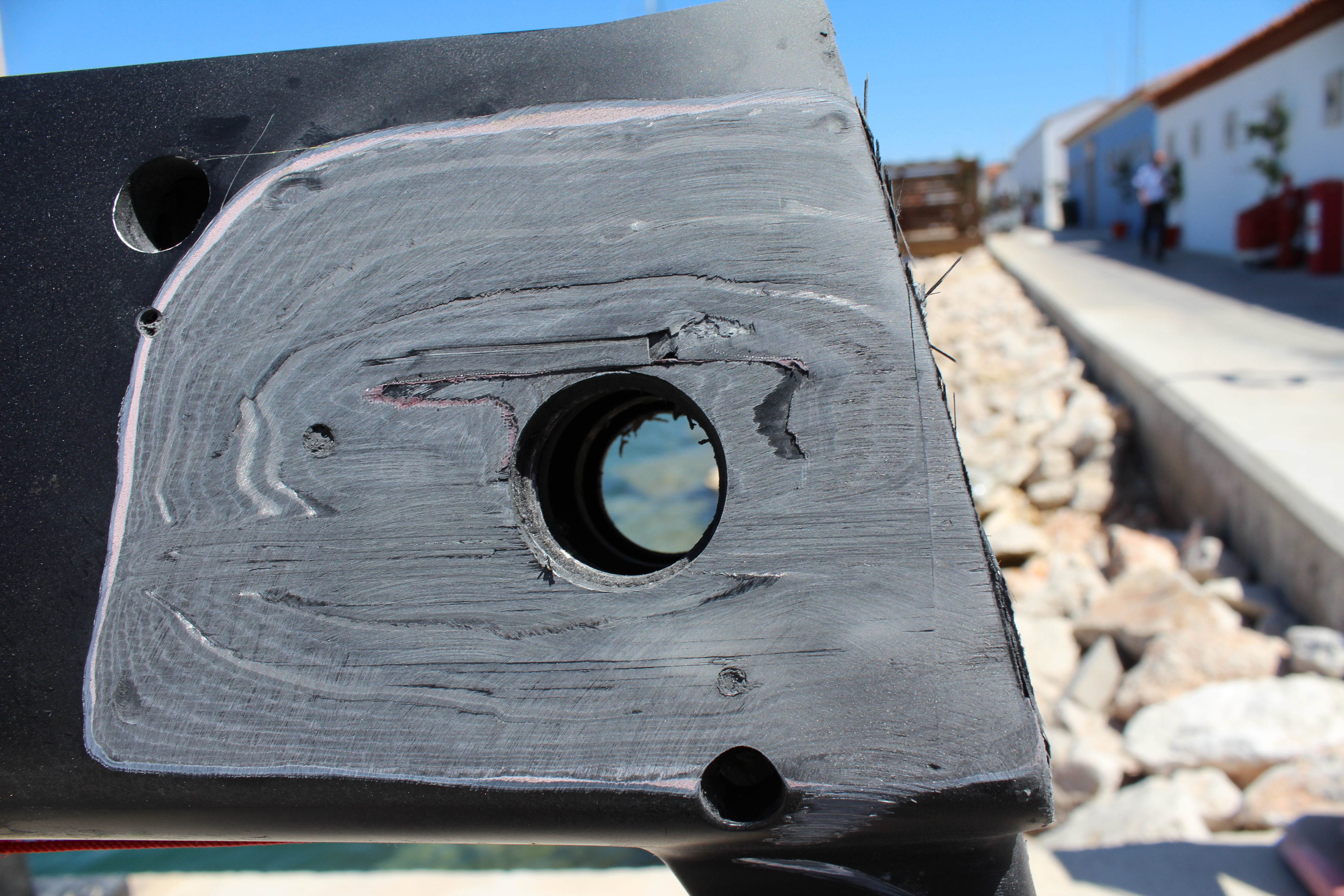 | 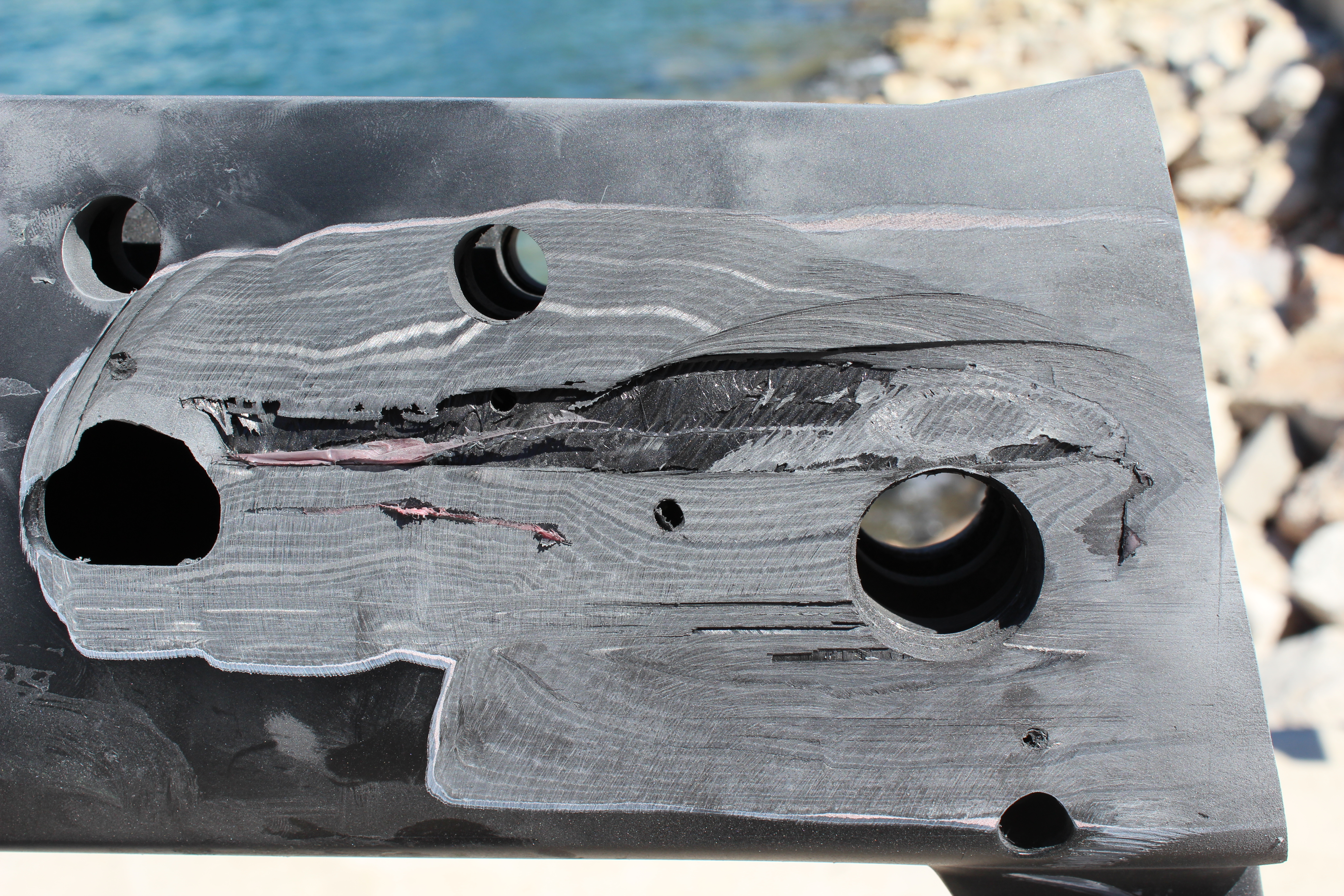 |
A mast is destroyed and sanded down to reveal a flaw. The flaw was first discovered using the EPOCH 650 flaw detector. |
marineSOLUTIONS continues to invest in Olympus products. “We have never been disappointed with field support and reliability of products,” said Cem.
Cem added, "Olympus ultrasonic testing equipment offers unquestionable and reliable results. Olympus is a reputable and well-established name for ultrasound NDT. Our customers have carried some of our ultrasound findings to courts in multiple countries around the world with reproducible success."
Related Content
Composite Inspection Solutions
Detecting Laminar Cracking in Fiberglass Using Ultrasonic Flaw Detection
Ultrasonic Flaw Detection Tutorial
Get In Touch
